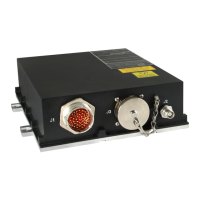INSTALLATION MANUAL
CMA-5024 GLSSU
This document includes Proprietary Information and shall not be reproduced or communicated to third party
without prior written permission by CMC Electronics Inc.
Page 3
Revision 1 Jan 19, 2009
WAAS:
http://www.faa.gov/airports_airtraffic/technology/waas/ and http://www.nstb.tc.faa.gov/index.htm
EGNOS:
http://www.esa.int/esaNA/egnos.html
MSAS:
http://www.kasc.go.jp/_english/msas_01.htm
The equipment consists of one LRU as per Figure 1. The GLSSU is intended to be operated using a
Controller Unit, such as a Flight Management System (FMS).
Figure 1. CMA-5024 GLSSU
(Note: The GLSSU is shown with the protective metal cap on the connector J3.)
The GLSSU is designed to be connected to a commercially available active antenna (not illustrated),
compliant with RTCA/DO-301 and TSO-C190; it does not require a specific antenna per the definition of
RTCA/DO-229D section 2.1.1.10. If the aircraft operation is limited to class 1 as defined above, use of
an RTCA/DO-228 Change 1 compliant active antenna is acceptable. Refer to section II.3.A for antenna
characteristics.
The GLSSU includes an Aircraft Personality Data file (APD File) that contains from one up to sixteen
individual aircraft-specific APD Configurations. Within the APD File, a specific APD Configuration will be
selected at installation time, for configuring automatically the input/outputs and internal parameters of
the GLSSU to match the specific characteristics of each individual aircraft installation. The APD File
gives the flexibility of adapting a single GLSSU to the needs of several aircraft and installation types
within a large fleet. Refer to Appendix E for a detailed description of the parameters controlled by the
APD Configuration, and of the readily available APD Files and APD Configurations.
B. Functions
The GLSSU is an SBAS-based sensor that provides position information with integrity to a multi-sensor
navigation system, a flight management system, or other area navigation systems. It provides integrity
The document reference is online, please check the correspondence between the online documentation and the printed version.

